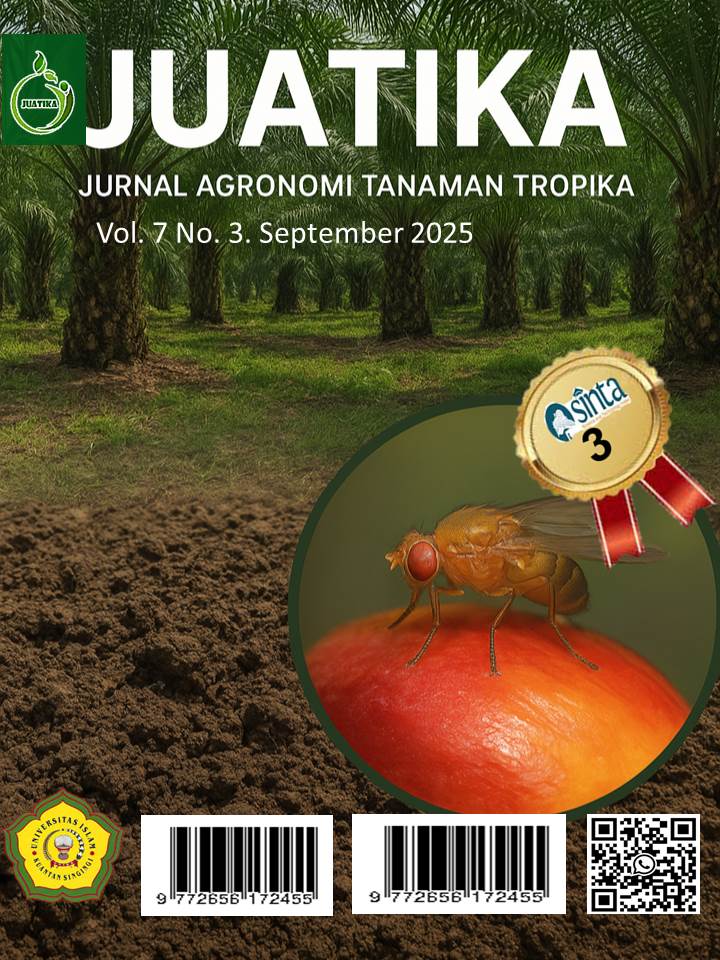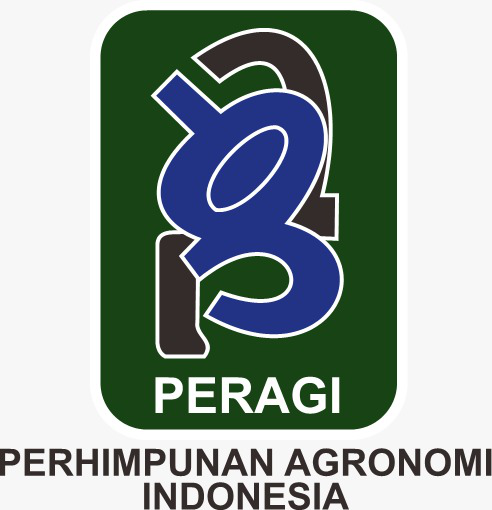Identification and Diversity of Mycorrhizae in Several Rhizosphere Vegetation Plants in Former Mining Land for Gambir Planting
Abstract
Post-mining land represents an ecosystem that has undergone severe degradation as a result of mineral resource exploitation. The mining process causes the loss of the topsoil layer, which is rich in organic matter, microorganisms, and essential nutrients, leading to nutrient-poor, compacted, and acidic soils that are often contaminated with heavy metals. The cultivation of gambier has been proposed as a strategy to optimize the use of post-mining land. One initial approach to address this problem is the application of arbuscular mycorrhizal fungi (AMF). Soil conditions and the type of host vegetation strongly influence the diversity of AMF in post-mining areas. Therefore, identifying the presence of AMF in post-mining soils is necessary. Soil samples were collected from PT Atoz Nusantara Mining, located in Kenagarian Tambang, IV Jurai Subdistrict, Pesisir Selatan Regency. This exploratory study involved soil analysis and the identification of arbuscular mycorrhizal fungi. The plant species sampled included alang-alang (Imperata cylindrica), resam nail (Dicranopteris linearis), caramunting (Melastoma malabathricum), telang (Clitoria ternatea), sedge grass (Cyperus rotundus), and sembung (Blumea balsamifera). The results indicated that the occurrence of mycorrhizae in the rhizosphere varied across post-mining sites, with identified species including Acaulospora sp., Glomus sp. 1, Glomus sp. 2, Sclerocystis sp., and Gigaspora sp. These mycorrhizae demonstrate potential for restoring soil fertility in post-mining areas.
Downloads
References
Alayya, N. P., & Prasetya, B. (2022). Kepadatan spora dan persen koloni mikoriza vesikula arbuskula (MVA) pada beberapa tanaman pangan di lahan pertanian Kecamatan Jabung, Malang. Jurnal Tanah dan Sumberdaya Lahan, 9(2), 267–276. https://doi.org/10.21776/ub.jtsl.2022.009.2.7
Armansyah, A., Herawati, N., & Kristina, N. (2019). Keanekaragaman fungi mikoriza arbuskula (FMA) di rizosfer tanaman bengkuang (Pachyrhizus erosus (L.) Mrb.) pada berbagai tipe rotasi pertanaman. Jagur: Jurnal Agroteknologi, 3(1), 8–14. https://doi.org/10.25077/jagur.3.1.8-14.2019
Asmelash, F., Bekele, T., & Birhane, E. (2016). The potential role of arbuscular mycorrhizal fungi in the restoration of degraded lands. Frontiers in Microbiology, 7(JUL), 1–15. https://doi.org/10.3389/fmicb.2016.01095
Bimantara, M. A., Rahmat, H. K., & Hidayat, M. (2024). Revitalisasi lahan bekas tambang sebagai langkah rehabilitasi bencana: Sebuah tinjauan konseptual. Trends in Applied Sciences, Social Science, and Education, 2(2), 119–134. https://doi.org/10.71383/tase.v2i2.59
Brundrett, M. (2004). Diversity and classification of mycorrhizal associations. Biological Reviews, 79, 473–495.
Caravaca, F., Barea, J. M., Figueroa, D., & Roldán, A. (2002). Assessing the effectiveness of mycorrhizal inoculation and soil compost addition for enhancing reafforestation with Olea europaea subsp. sylvestris through changes in soil biological and physical parameters. Applied Soil Ecology, 20(2), 107–118. https://doi.org/10.1016/S0929-1393(02)00015-X
Gai, J. P., Christie, P., Feng, G., & Li, X. L. (2006). Twenty years of research on community composition and species distribution of arbuscular mycorrhizal fungi in China: A review. Mycorrhiza, 16(4), 229–239. https://doi.org/10.1007/s00572-005-0023-8
INVAM. (2020). International Culture Collection of Vesicular Arbuscular Mycorrhizal Fungi (US): The fungi—Classification, nomenclature and species descriptions. http://invam.caf.wvu.edu
Lopita, S., Zainal, A., & Hervani, D. (2024). The effectiveness of arbuscular mycorrhizal fungi (AMF) on gambier seedlings (Uncaria gambir (Hunter) Roxb.) growth on former coal mining land. Jurnal Agronomi Tanaman Tropika (Juatika), 6(3). https://doi.org/10.36378/juatika.v6i3.3683
Moh, E. E. M., Junaedi, A., Wachjar, A., & Mansur, I. (2016). Karakterisasi fungi mikoriza arbuskula pada rhizosfer aren (Arenga pinnata (Wurmb) Merr.): Characterization of arbuscular mycorrhizal fungus from sugar palm (Arenga pinnata (Wurmb) Merr.) in West Java and Banten. Jurnal Silvikultur Tropika, 7(1), 18–23.
Mulyani, A., Ritung, S., & Las, I. (2011). Potensi dan ketersediaan sumberdaya lahan. Jurnal Litbang Pertanian, 30(2), 73–80.
Puspitasari, D., Purwani, K. I., & Muhibuddin, A. (2012). Eksplorasi vesicular arbuscular mycorrhiza (VAM) indigenous pada lahan jagung di Desa Torjun, Sampang, Madura. Jurnal Sains dan Seni ITS, 1, 19–22.
Tuheteru, F. D., Husna, Albasri, Arif, A., Wulan, S. A., & Kramadibrata, K. (2019). Arbuscular mycorrhizal fungi associated with adaptive plants in gold mine tailing. Biodiversitas, 20(11), 3398–3404. https://doi.org/10.13057/biodiv/d201137
Copyright (c) 2025 Rangga Arnelio, Aprizal Zainal, Benni Satria

This work is licensed under a Creative Commons Attribution 4.0 International License.
Authors who publish with Jurnal Agronomi Tanaman Tropika (JUATIKA) agree to the following terms:
Authors retain copyright and grant the Jurnal Agronomi Tanaman Tropika (JUATIKA) right of first publication with the work simultaneously licensed under a Creative Commons Attribution License (CC BY 4.0) that allows others to share (copy and redistribute the material in any medium or format) and adapt (remix, transform, and build upon the material for any purpose, even commercially) with an acknowledgment of the work's authorship and initial publication in Jurnal Agronomi Tanaman Tropika (JUATIKA).
Authors are able to enter into separate, additional contractual arrangements for the non-exclusive distribution of the journal's published version of the work (e.g., post it to an institutional repository or publish it in a book), with an acknowledgment of its initial publication in Jurnal Agronomi Tanaman Tropika (JUATIKA). Authors are permitted and encouraged to post their work online (e.g., in institutional repositories or on their website) prior to and during the submission process, as it can lead to productive exchanges, as well as earlier and greater citation of published work.







 More Information
More Information



